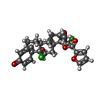Entry Database : PDB / ID : 4p6wTitle Crystal Structure of mometasone furoate-bound glucocorticoid receptor ligand binding domain Glucocorticoid receptor Nuclear receptor coactivator 2 Keywords / / / / / Function / homology Function Domain/homology Component
/ / / / / / / / / / / / / / / / / / / / / / / / / / / / / / / / / / / / / / / / / / / / / / / / / / / / / / / / / / / / / / / / / / / / / / / / / / / / / / / / / / / / / / / / / / / / / / / / / / / / / / / / / / / / / / / / / / / / / / / / / / / / / / / / / / / / / / / / / / / / / / / / / / / / / / / / / / / / / / / Biological species Homo sapiens (human)Method / / / Resolution : 1.951 Å Authors He, Y. / Zhou, X.E. / Tolbert, W.D. / Powell, K. / Melcher, K. / Xu, H.E. Funding support Organization Grant number Country National Institutes of Health/National Institute of Diabetes and Digestive and Kidney Disease (NIH/NIDDK) DK066202 National Institutes of Health/National Institute of Diabetes and Digestive and Kidney Disease (NIH/NIDDK) DK071662 AAF 2010 senior award
Journal : Cell Res. / Year : 2014Title : Structures and mechanism for the design of highly potent glucocorticoids.Authors : He, Y. / Yi, W. / Suino-Powell, K. / Zhou, X.E. / Tolbert, W.D. / Tang, X. / Yang, J. / Yang, H. / Shi, J. / Hou, L. / Jiang, H. / Melcher, K. / Xu, H.E. History Deposition Mar 25, 2014 Deposition site / Processing site Revision 1.0 Apr 16, 2014 Provider / Type Revision 1.1 May 7, 2014 Group Revision 1.2 Jul 16, 2014 Group Revision 1.3 Sep 27, 2017 Group Author supporting evidence / Derived calculations ... Author supporting evidence / Derived calculations / Other / Refinement description / Source and taxonomy Category entity_src_gen / pdbx_audit_support ... entity_src_gen / pdbx_audit_support / pdbx_database_status / pdbx_entity_src_syn / pdbx_struct_assembly / pdbx_struct_assembly_gen / pdbx_struct_assembly_prop / pdbx_struct_oper_list / software Item _entity_src_gen.pdbx_alt_source_flag / _pdbx_audit_support.funding_organization ... _entity_src_gen.pdbx_alt_source_flag / _pdbx_audit_support.funding_organization / _pdbx_database_status.pdb_format_compatible / _pdbx_entity_src_syn.pdbx_alt_source_flag / _pdbx_struct_assembly.oligomeric_details / _pdbx_struct_assembly_gen.asym_id_list / _pdbx_struct_assembly_prop.type / _pdbx_struct_assembly_prop.value / _pdbx_struct_oper_list.symmetry_operation Revision 1.4 Dec 25, 2019 Group / Category / Item Revision 1.5 Dec 27, 2023 Group / Database references / Refinement descriptionCategory chem_comp_atom / chem_comp_bond ... chem_comp_atom / chem_comp_bond / database_2 / refine_hist Item _database_2.pdbx_DOI / _database_2.pdbx_database_accession ... _database_2.pdbx_DOI / _database_2.pdbx_database_accession / _refine_hist.pdbx_number_atoms_nucleic_acid / _refine_hist.pdbx_number_atoms_protein
Show all Show less
 Yorodumi
Yorodumi Open data
Open data Basic information
Basic information Components
Components Keywords
Keywords mometasone furoate /
mometasone furoate /  glucocorticoid receptor / potency / HORMONE-HORMONE RECEPTOR complex / HORMONE RECEPTOR-HORMONE ACTIVATOR complex
glucocorticoid receptor / potency / HORMONE-HORMONE RECEPTOR complex / HORMONE RECEPTOR-HORMONE ACTIVATOR complex Function and homology information
Function and homology information steroid hormone binding / PTK6 Expression / glucocorticoid metabolic process / neuroinflammatory response / microglia differentiation /
steroid hormone binding / PTK6 Expression / glucocorticoid metabolic process / neuroinflammatory response / microglia differentiation /  maternal behavior / mammary gland duct morphogenesis ...Regulation of NPAS4 gene transcription / regulation of glucocorticoid biosynthetic process / nuclear glucocorticoid receptor activity /
maternal behavior / mammary gland duct morphogenesis ...Regulation of NPAS4 gene transcription / regulation of glucocorticoid biosynthetic process / nuclear glucocorticoid receptor activity /  steroid hormone binding / PTK6 Expression / glucocorticoid metabolic process / neuroinflammatory response / microglia differentiation /
steroid hormone binding / PTK6 Expression / glucocorticoid metabolic process / neuroinflammatory response / microglia differentiation /  maternal behavior / mammary gland duct morphogenesis / nucleus localization / astrocyte differentiation / cellular response to glucocorticoid stimulus /
maternal behavior / mammary gland duct morphogenesis / nucleus localization / astrocyte differentiation / cellular response to glucocorticoid stimulus /  motor behavior /
motor behavior /  regulation of gluconeogenesis / adrenal gland development / RNA polymerase II intronic transcription regulatory region sequence-specific DNA binding / cellular response to steroid hormone stimulus / locomotor rhythm /
regulation of gluconeogenesis / adrenal gland development / RNA polymerase II intronic transcription regulatory region sequence-specific DNA binding / cellular response to steroid hormone stimulus / locomotor rhythm /  aryl hydrocarbon receptor binding / regulation of lipid metabolic process / cellular response to Thyroglobulin triiodothyronine / regulation of glucose metabolic process / Synthesis of bile acids and bile salts / Endogenous sterols /
aryl hydrocarbon receptor binding / regulation of lipid metabolic process / cellular response to Thyroglobulin triiodothyronine / regulation of glucose metabolic process / Synthesis of bile acids and bile salts / Endogenous sterols /  estrogen response element binding / Synthesis of bile acids and bile salts via 27-hydroxycholesterol / FOXO-mediated transcription of oxidative stress, metabolic and neuronal genes / Synthesis of bile acids and bile salts via 7alpha-hydroxycholesterol / intracellular steroid hormone receptor signaling pathway / core promoter sequence-specific DNA binding / Recycling of bile acids and salts / regulation of cellular response to insulin stimulus / cellular response to hormone stimulus / cellular response to transforming growth factor beta stimulus / positive regulation of adipose tissue development / HSP90 chaperone cycle for steroid hormone receptors (SHR) in the presence of ligand / peroxisome proliferator activated receptor signaling pathway / RORA activates gene expression / TBP-class protein binding / Regulation of lipid metabolism by PPARalpha /
estrogen response element binding / Synthesis of bile acids and bile salts via 27-hydroxycholesterol / FOXO-mediated transcription of oxidative stress, metabolic and neuronal genes / Synthesis of bile acids and bile salts via 7alpha-hydroxycholesterol / intracellular steroid hormone receptor signaling pathway / core promoter sequence-specific DNA binding / Recycling of bile acids and salts / regulation of cellular response to insulin stimulus / cellular response to hormone stimulus / cellular response to transforming growth factor beta stimulus / positive regulation of adipose tissue development / HSP90 chaperone cycle for steroid hormone receptors (SHR) in the presence of ligand / peroxisome proliferator activated receptor signaling pathway / RORA activates gene expression / TBP-class protein binding / Regulation of lipid metabolism by PPARalpha /  steroid binding / cellular response to dexamethasone stimulus / BMAL1:CLOCK,NPAS2 activates circadian gene expression / SUMOylation of transcription cofactors / nuclear receptor coactivator activity / Activation of gene expression by SREBF (SREBP) / response to progesterone /
steroid binding / cellular response to dexamethasone stimulus / BMAL1:CLOCK,NPAS2 activates circadian gene expression / SUMOylation of transcription cofactors / nuclear receptor coactivator activity / Activation of gene expression by SREBF (SREBP) / response to progesterone /  synaptic transmission, glutamatergic /
synaptic transmission, glutamatergic /  chromosome segregation /
chromosome segregation /  nuclear receptor binding / RNA polymerase II transcription regulatory region sequence-specific DNA binding /
nuclear receptor binding / RNA polymerase II transcription regulatory region sequence-specific DNA binding /  Hsp90 protein binding / circadian regulation of gene expression / SUMOylation of intracellular receptors / Heme signaling / mRNA transcription by RNA polymerase II / Activated PKN1 stimulates transcription of AR (androgen receptor) regulated genes KLK2 and KLK3 / Transcriptional activation of mitochondrial biogenesis / PPARA activates gene expression / Cytoprotection by HMOX1 / spindle / DNA-binding transcription repressor activity, RNA polymerase II-specific / Transcriptional regulation of white adipocyte differentiation / positive regulation of miRNA transcription / Nuclear Receptor transcription pathway / RNA polymerase II transcription regulator complex / Regulation of RUNX2 expression and activity / positive regulation of neuron apoptotic process /
Hsp90 protein binding / circadian regulation of gene expression / SUMOylation of intracellular receptors / Heme signaling / mRNA transcription by RNA polymerase II / Activated PKN1 stimulates transcription of AR (androgen receptor) regulated genes KLK2 and KLK3 / Transcriptional activation of mitochondrial biogenesis / PPARA activates gene expression / Cytoprotection by HMOX1 / spindle / DNA-binding transcription repressor activity, RNA polymerase II-specific / Transcriptional regulation of white adipocyte differentiation / positive regulation of miRNA transcription / Nuclear Receptor transcription pathway / RNA polymerase II transcription regulator complex / Regulation of RUNX2 expression and activity / positive regulation of neuron apoptotic process /  nuclear receptor activity /
nuclear receptor activity /  Circadian Clock / sequence-specific double-stranded DNA binding /
Circadian Clock / sequence-specific double-stranded DNA binding /  gene expression / chromatin organization / HATs acetylate histones / DNA-binding transcription activator activity, RNA polymerase II-specific / Estrogen-dependent gene expression /
gene expression / chromatin organization / HATs acetylate histones / DNA-binding transcription activator activity, RNA polymerase II-specific / Estrogen-dependent gene expression /  transcription regulator complex / Potential therapeutics for SARS /
transcription regulator complex / Potential therapeutics for SARS /  transcription coactivator activity /
transcription coactivator activity /  protein dimerization activity /
protein dimerization activity /  nuclear body / DNA-binding transcription factor activity, RNA polymerase II-specific /
nuclear body / DNA-binding transcription factor activity, RNA polymerase II-specific /  mitochondrial matrix / nuclear speck / RNA polymerase II cis-regulatory region sequence-specific DNA binding / DNA-binding transcription factor activity /
mitochondrial matrix / nuclear speck / RNA polymerase II cis-regulatory region sequence-specific DNA binding / DNA-binding transcription factor activity /  cell division / protein domain specific binding /
cell division / protein domain specific binding /  centrosome / negative regulation of DNA-templated transcription /
centrosome / negative regulation of DNA-templated transcription /  synapse / apoptotic process /
synapse / apoptotic process /  chromatin binding /
chromatin binding /  chromatin / regulation of DNA-templated transcription / regulation of transcription by RNA polymerase II /
chromatin / regulation of DNA-templated transcription / regulation of transcription by RNA polymerase II /  protein kinase binding / negative regulation of transcription by RNA polymerase II /
protein kinase binding / negative regulation of transcription by RNA polymerase II /  signal transduction
signal transduction
 Homo sapiens (human)
Homo sapiens (human) X-RAY DIFFRACTION /
X-RAY DIFFRACTION /  SYNCHROTRON /
SYNCHROTRON /  MOLECULAR REPLACEMENT / Resolution: 1.951 Å
MOLECULAR REPLACEMENT / Resolution: 1.951 Å  Authors
Authors United States, 3items
United States, 3items  Citation
Citation Journal: Cell Res. / Year: 2014
Journal: Cell Res. / Year: 2014 Structure visualization
Structure visualization Molmil
Molmil Jmol/JSmol
Jmol/JSmol Downloads & links
Downloads & links Download
Download 4p6w.cif.gz
4p6w.cif.gz PDBx/mmCIF format
PDBx/mmCIF format pdb4p6w.ent.gz
pdb4p6w.ent.gz PDB format
PDB format 4p6w.json.gz
4p6w.json.gz PDBx/mmJSON format
PDBx/mmJSON format Other downloads
Other downloads https://data.pdbj.org/pub/pdb/validation_reports/p6/4p6w
https://data.pdbj.org/pub/pdb/validation_reports/p6/4p6w ftp://data.pdbj.org/pub/pdb/validation_reports/p6/4p6w
ftp://data.pdbj.org/pub/pdb/validation_reports/p6/4p6w Links
Links Assembly
Assembly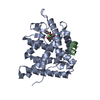
 Components
Components / GR / Nuclear receptor subfamily 3 group C member 1
/ GR / Nuclear receptor subfamily 3 group C member 1
 Homo sapiens (human) / Gene: NR3C1, GRL / Production host:
Homo sapiens (human) / Gene: NR3C1, GRL / Production host: 
 Escherichia coli (E. coli) / Strain (production host): K-12 / References: UniProt: P04150
Escherichia coli (E. coli) / Strain (production host): K-12 / References: UniProt: P04150 / NCoA-2 / Class E basic helix-loop-helix protein 75 / bHLHe75 / Transcriptional intermediary factor 2 / hTIF2
/ NCoA-2 / Class E basic helix-loop-helix protein 75 / bHLHe75 / Transcriptional intermediary factor 2 / hTIF2
 Homo sapiens (human) / References: UniProt: Q15596
Homo sapiens (human) / References: UniProt: Q15596 Mometasone
Mometasone Water
Water X-RAY DIFFRACTION / Number of used crystals: 1
X-RAY DIFFRACTION / Number of used crystals: 1  Sample preparation
Sample preparation
 SYNCHROTRON / Site:
SYNCHROTRON / Site:  APS
APS  / Beamline: 21-ID-D / Wavelength: 0.987 Å
/ Beamline: 21-ID-D / Wavelength: 0.987 Å : 0.987 Å / Relative weight: 1
: 0.987 Å / Relative weight: 1  Processing
Processing :
:  MOLECULAR REPLACEMENT / Resolution: 1.951→29.874 Å / SU ML: 0.23 / Cross valid method: FREE R-VALUE / σ(F): 1.34 / Phase error: 23.67 / Stereochemistry target values: ML
MOLECULAR REPLACEMENT / Resolution: 1.951→29.874 Å / SU ML: 0.23 / Cross valid method: FREE R-VALUE / σ(F): 1.34 / Phase error: 23.67 / Stereochemistry target values: ML Movie
Movie Controller
Controller



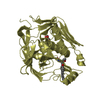
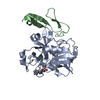
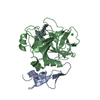
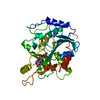
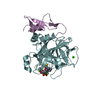
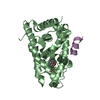
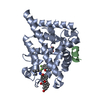
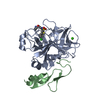

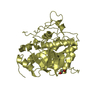

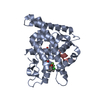
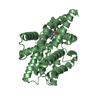
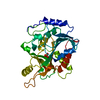
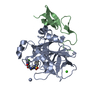
 PDBj
PDBj
















